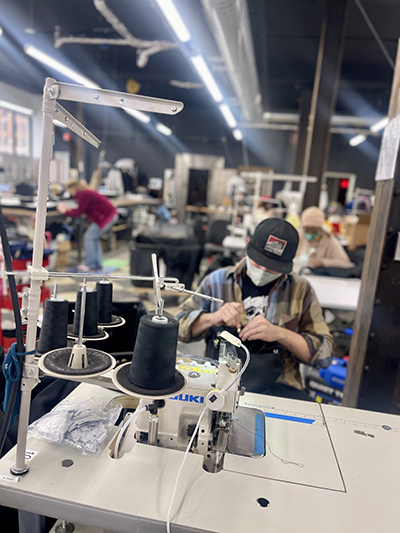
Supply chain issues and labor shortages are affecting manufacturers of all sizes, but small businesses have another question to answer: How can they compete with lower-priced overseas competitors, particularly those in China?
Karen Buscemi, owner of apparel manufacturer Detroit Sewn, based in Pontiac, caught a break at the outset of the COVID-19 pandemic when personal protection equipment (PPE) like masks and gowns were in short supply. But after experiencing a surge of initial orders, in recent months demand has tapered off and Buscemi and other small manufacturers are back to competing with cheaper overseas suppliers.
“Once China released the ships that had the PPE and it finally made it over here, most of the hospitals went right back to using disposable masks,” Buscemi says. “Costs are what makes it difficult to be a profitable cut-and-sew (operation) in the United States.
“Even though everybody understands how much people are paid in China, and (realize that) in some instances there’s forced labor in horrible working conditions, and all of the (other) factors that make that product ridiculously cheap to make, people still look at the price.”
And that, according to Buscemi, makes it important for U.S. makers to cater to buyers who are looking for higher-quality products. Working with local suppliers also keeps revenue from leaving a given region or state.
“You shouldn’t be making anything that’s disposable fashion,” she says. “You should be making higher-end, quality pieces. That’s what we’re going to be able to do best in the U.S., (to) make an impact. It’s really all about how you market and find the audience that cares.”
Buscemi and other apparel manufacturers are challenged by another workforce issue, as well.
“When (apparel) work (first) went overseas many years ago, the workers that were here aged out,” she says. “Now there’s a big gap in the workforce in industrial sewing.”
Although the sector isn’t typically included among the list of skilled workers who need training, Buscemi says the industry is taking care of that itself. “It has changed quite a bit in the fashion arena since I started six years ago,” she notes. “When it comes to cut-and-sew, there’s a lot more education being built here now, which is also good.”
Automation sometimes can be the answer to a lack of skilled workers, but that’s not the case in the apparel industry.
“When it comes to sewing, it’s still a hands-on thing,” says Buscemi, whose company has purchased automated snap equipment. “Unless you’re making the same product in the same size over and over and over, it wouldn’t make sense to invest the kind of money you’d need to automate something like that.”













